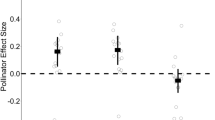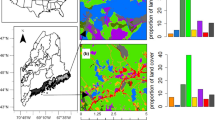Abstract
The world’s only intensively managed ground-nesting bee, the alkali bee (Nomia melanderi Cockerell), has been used for >50 years as an effective pollinator of alfalfa (Medicago saliva L.) grown for seed in the western USA. Across a 240 km2 watershed in Washington, the 24 most populous of 56 nest sites found were annually surveyed for nesting bees for 8 years. Alkali bees multiplied 9-fold to 17 million females, the largest reported metapopulation of non-social bees. Several sites have remained populous for an unprecedented 50 years. The most populous nesting bed (1.5 ha) grew to 5.3 million nesting females (median = 278 nests/m2), the largest bee nesting aggregation ever recorded. This first-ever exhaustive landscape-level survey for any non-social bee reveals that even amid intensive conventional agriculture, a native bee can sustainably multiply to vast numbers, its nesting aggregations persisting for decades.
Zusammenfassung
Die Alkalibiene (Nomia melanderi) ist die weltweit einzige bodennistende Biene, die intensiv genutzt wird. Im Westen der USA wird sie seit über 50 Jahren als effizienter Bestäuber für Alfalfa (Medicago saliva L.) gehalten. In dem 240 km2 grossen Touchet Tal, einer Alfalfa-Anbauregion im Staat Washington (Abb. 1), wurden die 24 populationsstärksten der 56 Nestaggregationen (Abb. 5) zwischen 1999 und 2006 in jährlichen Bestandsaufnahmen begutachtet (Abb. 6). Das Tal, das mit 2000–4000 ha an Alfalfa-Blütenfläche 1/4 der gesamten US-Produktion darstellt, wies innerhalb dieser acht Jahre einen neunfachen Anstieg in der Zahl an Alkalibienen auf (Abb. 4). Im Jahr 2006 wurden 17 Millionen Weibchen in dichten Nestaggregationen auf knapp 20 ha Talweite registriert (Abb. 2 und 3). Dies stellt damit die nachgewiesenermaßen grösste Metapopulation nichtsozialer Bienen dar, und mehrere Populationen sind seit über 50 Jahren und damit wesenlich länger registriert als andere Aggregationen von Bienennestern. Das am dichtesten besiedelte Nestbett mit 1,5 ha wuchs in dieser Zeit auf 5,3 Millionen nistender Weibchen an. Mit einer Dichte von über 1000 Nestern/m2 ist dies die grösste zahlenmässig erfasste Aggregation von Bienennestern. Die Pflegepraxis für die Haltung der Alkalibienen beinhaltet: angemessene Bewässerung der Nistflächen, Ausbringung von Salz auf der Bodenoberfläche und Unkrautentfernung, Bereitstellung einer adäquaten Alfalfablüte in Nestnähe, teilweise Parasitenkontrolle und bienensichere Praxis in der Ausbringung von Insektiziden. Lediglich eine nichtangemessene Bewässerung führte im Beobachtungszeitraum zu Verlusten inerhalb der Nistpopulationen. Diese umfassende regionalweite Bestandsaufnahme zeigte, dass eine gregäre einheimische Biene selbst in einem intensiv konventionell bewirtschafteten Landschaftsraum einen erheblichen Anstieg in den Individuenzahlen aufwies, und dass sich die Populationen für zumindest ein halbes Jahrhundert stabil hielten.
Similar content being viewed by others
References
Alexander B., Rozen J.G. Jr. (1987) Ovaries, ovarioles, and oocytes in parasitic bees (Hymenoptera: Apoidea), Pan-Pacific Entomol. 63, 155–164.
Archer M.E. (1989) The wasps and bees (Hymenoptera, Aculeata) of Allerthorpe Common England UK before and after coniferization, Naturalist 114, 129–136.
Bischoff I. (2003) Population dynamics of the solitary digger bee Andrena vaga Panzer (Hymenoptera, Andrenidae) studied using mark-recapture and nest counts, Popul. Ecol. 45, 197–204.
Blagoveschenskaya N.N. (1963) Giant colony of the solitary bee Dasypoda plumipes Pz., Entomol. Obozr. 42, 115–117.
Bohart G.E. (1970) The evolution of parasitism among bees, in: Faculty Honor Lecture Utah State University, Logan, 41, 30 p.
Bohart G.E., Cross E.A. (1955) Time relationships in the nest construction and life cycle of the alkali bee, Ann. Entomol. Soc. Am. 48, 403–406.
Bohart G.E., Stephen W.P., Eppley R.K. (1960) The biology of Heterostylum robustum (Diptera: Bombyliidae), a parasite of the alkali bee, Ann. Entomol. Soc. Am. 53, 425–435.
Bosch J. (1994) The nesting behaviour of the mason bee Osmia cornuta (Latr) with special reference to its pollinating potential (Hymenoptera, Megachilidae), Apidologie 25, 84–93.
Cane J.H. (1997) Ground-nesting bees: the neglected pollinator resource for agriculture, in: Richards K.W. (Ed.), Pollination: from theory to practice, Acta Hortic, Leiden, pp. 309–324.
Cane J.H. (2002) Pollinating bees (Hymenoptera: Apiformes) of U.S. alfalfa compared for rates of pod and seed set, J. Econ. Entomol. 95, 22–27.
Cane J.H. (2003a) Annual displacement of soil in nest tumuli of alkali bees (Nomia melanderi) (Hymenoptera: Apiformies: Halictidae) across an agricultural landscape, J. Kans. Entomol. Soc. 76, 172–176.
Cane J.H. (2003b) Exotic non-social bees (Hymenoptera: Apoidea) in North America: Ecological implications, in: Strickler K.V., Cane J.H. (Eds.), For non-native crops, whence pollinators of the future? Thomas Say Publications in Entomology, Entomological Society of America, Lanham, MD, pp. 113–126.
Cane J.H., Schiffhauer D., Kervin L.J. (1996) Pollination, foraging, and nesting ecology of the leaf-cutting bee Megachile (Delomegachile) addenda (Hymenoptera: Megachilidae) on cranberry beds, Ann. Entomol. Soc. Am. 89, 361–367.
Cockerell T.D.A. (1933) The excessive abundance of certain bees, Am. Nat. 67, 1–3.
Eck P. (1986) Cranberry, in: Monselise S.P. (Ed.), CRC Handbook of fruit set and development, CRC Press, Boca Raton, Florida USA, pp. 109–117.
Farrar C.L., Bain H.F. (1946) Honeybees as pollinators of the cranberry, Am. Bee J. 86, 503–504.
Free J.B. (1993) Insect pollination of crops, Academic Press, New York.
Friese H. (1923) Die europaischen Bienen (Apidae), Walter de Gruyter and Co., Berlin.
Fronk W.D., Painter L.I. (1960) Some characteristics of alkali bee nesting sites, J. Econ. Entomol. 53, 424–425.
Johansen C.A., Mayer D.F. (1990) Pollinator protection: A bee and pesticide handbook, Wicwas Press, Cheshire, Conn.
Johansen C.A., Mayer D.F., Eves J.D. (1978) Biology and management of the alkali bee, Nomia melanderi Cockerell (Hymenoptera: Halictidae), Melanderia 28, 25–46.
Klein A.M., Vassiere B.E., Cane J., Steffan-Dewenter I., Cunningham S., Kremen C., Tscharntke T. (2007) Importance of pollinators in changing landscapes for world crops, Proc. R. Soc. B 274, 303–313.
Lesins K. (1950) Investigations into seed setting of lucerne at Ultuna, Sweden, 1945–1949, Ann. R. Agric. Coll. Sweden 17, 441–479.
Maeta Y., Sasaki Y., Fujimoto G. (1988) Andrena postomias of the Gakuonji temple in Hyogo prefecture, Insectarium 25, 50–57.
Mayer D.F., Johansen C.A. (1978) Bionomics of Meloe niger Kirby (Coleoptera: Meloidae) a predator of the alkali bee, Nomia melanderi Cockerell (Hymenoptera: Halictidae), Melanderia 28, 22.
Michener C.D. (1974) The social behavior of the bees: a comparative study, Harvard University of Press, Cambridge, Massachusetts.
Michener C.D. (2000) The bees of the world, Johns Hopkins Univ. Press., Baltimore.
Minckley R.L., Wcislo W.T., Yanega D., Buchmann S.L. (1994) Behavior and phenology of a specialist bee (Dieunomia) and sunflower (Helianthus) pollen availability, Ecology 75, 1406–1419.
Neff J.L. (2003) Nest and provisioning biology of the bee Panurginus polytrichus Cockerell (Hymenoptera: Andrenidae), with a description of a new Holcopasites species (Hymenoptera: Apidae), its probable nest parasite, J. Kans Entomol. Soc. 76, 203–216.
Packer L. (1988) The effect of Bombylius pulchellus (Diptera; Bombyliidae) and other mortality factors upon the biology of Halictus ligatus (Hymenoptera; Halictidae) in southern Ontario, Canada, Can. J. Zool. 66, 611–616.
Parker F.D., Batra S.W.T., Tepedino V.J. (1987) New pollinators for our crops, Agric. Zool. Rev. 2, 279–307.
Pedersen M.W., Nye W.P. (1962) Alfalfa seed production studies. Part II. Additional factors associated with seed yields, Utah Agric. Exp. Stn. Bull. 436, 9–22.
Pitts-Singer T.L. (2004) Examination of ‘pollen balls’ in nests of the alfalfa leafcutting bee, Megachile rotundata, J. Apic. Res. 43, 40–46.
Rozen J.G. Jr., Buchmann S.L. (1990) Nesting biology and immature stages of the bees Centris caesalpiniae, C. pallida and the cleptoparasite Ericrocis lata (Hymenoptera: Apoidea: Anthophoridae), Am. Mus. Novit. 2985, 30.
Stephen W.P. (1960) Artificial beds for the propagation of the alkali bee, Nomia melanderi, J. Econ. Entomol. 53, 1025–1030.
Thorp R.W. (1969) Ecology and behavior of Anthophora edwardsii (Hymenoptera: Anthophoridae), Am. Midl. Nat. 82, 321–337.
Vansell G.H., Todd F.E. (1946) Alfalfa tripping by insects, J. Am. Soc. Agron. 38, 470–488.
Wichelns D., Weaver T.F., Brooks P.M. (1992) Estimating the impact of alkali bees on the yield and acreage of alfalfa seed, J. Prod. Agric. 5, 512–518.
Williams N.M., Minckley R.L., Silveira F.A. (2001) Variation in native bee faunas and its implications for detecting community changes, Conserv. Ecol. 5, 57–86.
Author information
Authors and Affiliations
Corresponding author
Additional information
Manuscript editor: Jacqueline Pierre
Rights and permissions
About this article
Cite this article
Cane, J.H. A native ground-nesting bee (Nomia melanderi) sustainably managed to pollinate alfalfa across an intensively agricultural landscape. Apidologie 39, 315–323 (2008). https://doi.org/10.1051/apido:2008013
Received:
Revised:
Accepted:
Issue Date:
DOI: https://doi.org/10.1051/apido:2008013




